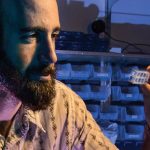Plant Biology
Here Comes The Sun: Cellular Sensor Helps Plants Find Light
The work upends previously held notions in the field. It was known that plants respond to diminished red light by activating a growth hormone called auxin to outpace its neighbors. However, this is the first time researchers have shown that shade avoidance can happen through an entirely different mechanism: instead of changing the levels of auxin, a cellular sensor called cryptochrome responds to diminished blue light by turning on genes that promote cell growth. This study is the first to show how cryptochromes promote growth in a shaded environment.
Read News Release Read More
Grafted Plants’ Genomes can Communicate with Each Other
Agricultural grafting dates back nearly 3,000 years. By trial and error, people from ancient China to ancient Greece realized that joining a cut branch from one plant onto the stalk of another could improve the quality of crops. Now, Joseph Ecker and collaborators have combined this ancient practice with modern genetic research to show that grafted plants can share epigenetic traits, according to a paper published the week of January 18, 2016 in PNAS.
The work showed that epigenetic information in the form of tiny molecules called sRNAs is transferred between the two plants and can change one another’s gene expression. sRNAs contribute to a gene silencing process called DNA methylation, where molecular markers bind along DNA to block the cell’s machinery from expressing the genes under the markers. It turns out that thousands of sites along the Arabidopsis thaliana genome were silenced by transferred sRNAs. The team plans to continue to explore the epigenetic effects of mobile RNA in other plants, pursuing revelations that could eventually help growers better manipulate crops.
Read MoreFeatured Stories
 Frontiers in Regenerative MedicineWhen Juan Carlos Izpisua Belmonte and his team at Salk made global news headlines last fall for developing a technique for growing...
Frontiers in Regenerative MedicineWhen Juan Carlos Izpisua Belmonte and his team at Salk made global news headlines last fall for developing a technique for growing... Next Gen: Zachary KatzZachary Katz is a visual person: from insect-devouring plants to bustling cells, he strives to see what happens in nature. While growing up in Arizona and then Florida, Katz and his brother gathered...
Next Gen: Zachary KatzZachary Katz is a visual person: from insect-devouring plants to bustling cells, he strives to see what happens in nature. While growing up in Arizona and then Florida, Katz and his brother gathered... An Interview with Salk President Elizabeth BlackburnWhen Jonas Salk announced the discovery of the polio vaccine in 1955, Elizabeth Blackburn was six years old and busy collecting...
An Interview with Salk President Elizabeth BlackburnWhen Jonas Salk announced the discovery of the polio vaccine in 1955, Elizabeth Blackburn was six years old and busy collecting...




















































